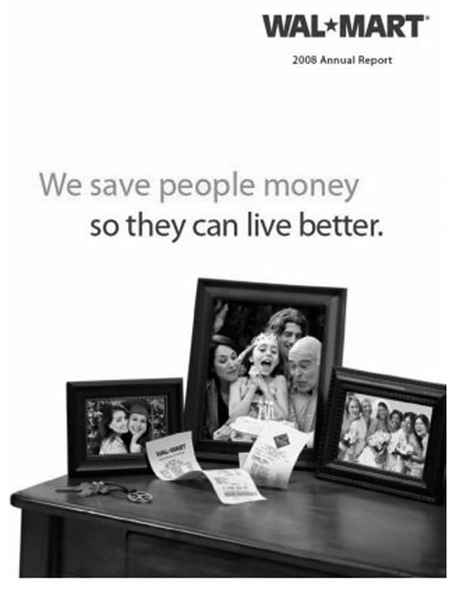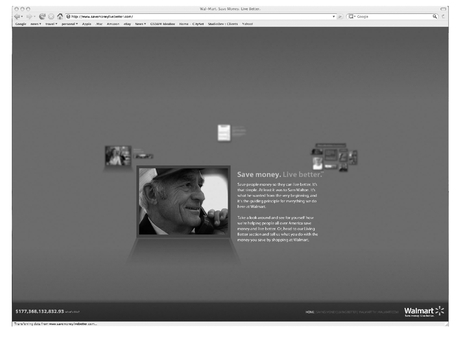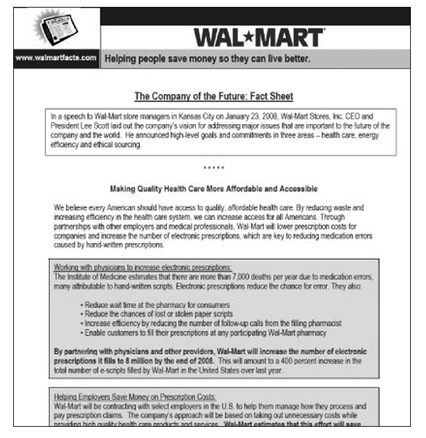11
HOW PURPOSE CAN MAKE YOU BETTER
To save people money so they can live better.
The history of brand-building at Wal-Mart follows a similar trajectory as Southwest Airlines. Wal-Mart spent decades building their brand with a strong set of core attributes—the lead being Every Day Low Prices. Then came a new generation of marketing leaders who had both studied and admired the transformation that took place at Southwest Airlines when they got out of the low fares and frequent flights business and laddered up to the freedom business. They were ready to discover and bring to life Wal-Mart’s purpose as well.
THE TRADITIONAL RETAIL BRAND-BUILDING MODEL
Retailers tend to build their brands on the backs of the 3Ps: products, pricing, and promotion. Because Wal-Mart shunned sales promotions in favor of Every Day Low Prices and Sam Walton believed so deeply in the Associates, Wal-Mart’s 3Ps were products, pricing, and people—with a heavy focus on pricing.
For years the brand was built with work that celebrated “Every day low prices on the brands you trust. Always.” Always was one of the most recognizable taglines in America, and it served to reinforce the trust that Wal-Mart shoppers had in the brand. They knew they would never be ripped off or given a raw deal—quite a valuable promise in the world of bait-and-switch promotions and 24-hour sales. That kind of blocking and tackling helped make Wal-Mart a hugely successful company. When we began working with Wal-Mart in 1986, they had sales of $8.5 billion. By 2004, their sales had grown to $315 billion. Not a bad run!
Moving from What You Sell to What You Stand For
But there came a day when Wal-Mart’s remarkable ability to drive down costs and save their customers money began to be demonized in the media. People no longer seemed to understand what the company really stood for—beyond low prices. Wal-Mart, still recognized for great value, was seen as devoid of
values. And as Doug Smith, management consultant and author of
On Value and Values, notes:
“Organizations that promote Value without Values, ultimately hollow out and sicken the collective soul.”1If you work for a corporation whose esteem is in peril (for whatever reason), it’s important to discover or rediscover the true value of your organization in the world. Your purpose won’t excuse you from righting legitimate wrongs or fixing things that are broken. However, it will explain your fundamental reason for being in a way that should restore the pride and reignite the momentum you need to move forward from a position of strength rather than weakness.
It was time for Wal-Mart to embrace and add a fourth P to their branding formula: purpose.
Like Schwab, Southwest, and a host of other clients discussed in this book, we didn’t have to manufacture a purpose. The leadership at Wal-Mart had always been focused on making a difference in the lives of their customers. Their business model had revolutionized and democratized the accessibility of merchandise around the world. It was time to develop a deeper understanding of the impact of the brand in the lives of Wal-Mart customers to create a brand that was as purpose based as the organization. Following Sam Walton’s famous adage, we began by turning to the customer for answers.
When you get confused go to the store, the customer has all the answers.
—Sam Walton
It’s important to recognize that Wal-Mart is not just an economic necessity for their shoppers—although many shoppers do credit Wal-Mart with helping them make ends meet. There are also many more who choose to shop at Wal-Mart because of the difference it makes in their life. Wal-Mart shoppers (and keep in mind that two thirds of America shop at Wal-Mart on a monthly basis) proactively choose to shop at Wal-Mart because the money they save translates into a better quality of life—a life with less financial stress, more opportunities, and the ability to say yes more often. It might mean sending their child to school with their head held high, taking a longer vacation with their family, feeding their family more organic foods, putting more presents under the Christmas tree, or saving for a college fund.
Whether you’re talking to an upper-income shopper, a member of the striving middle class, or a low-income shopper, each will be able to tell you how Wal-Mart enables them to live better:
Shopping at Wal-Mart makes me feel like I’m a good caretaker of our funds. With four children and four college educations to pay for down the road, saving money matters.
—Wal-Mart shopper with $400,000 household income in Plano, Texas
Here’s what I do. I go to the expensive stores and get all of the ideas and a sense of the look that I want. Then I go to Wal-Mart to pull it off for less.
—Wal-Mart shopper with $65,000 household income in Austin, Texas
The reality is that we’re trying to keep a roof over our kids’ heads, trying to feed them, trying to clothe them, trying to let them be proud when they go to school in the clothes they are wearing . . . and Wal-Mart helps us not bury ourselves under a load of bills to do it.
—Wal-Mart shopper with a $30,000 household income in Alameda, California
Highly engaged Wal-Mart Associates who are proud to work at Wal-Mart understand the role that Wal-Mart plays in the lives of their customers. Every day they see firsthand how people are affected by Wal-Mart. They see mothers able to say yes to their children more often, retirees able to afford all their prescriptions, and first-time home-owners able to outfit their homes with everything they need.
I love coming to work and seeing the looks on people’s faces when they realize that they’re able to afford something they’ve been wanting . . . or looking shocked when they get their receipt and realize that they haven’t blown their budget. It makes you feel good to be a part of that.
—Wal-Mart store manager
Finally, the leaders had always instinctively understood the purpose of Wal-Mart. In fact, one of the last public statements Mr. Sam ever made included a simple, profound explanation of what Wal-Mart could accomplish for the world:
If we work together, we’ll give the world an opportunity to see what it’s like to save, and have a better life.
—Sam Walton (in an acceptance speech for the George H.W. Bush Medal of Freedom)
We needed to capture the richness of what we learned from the customer, the passion we had heard from the very best Associates, and the simplicity of Sam Walton’s observation about Wal-Mart’s role in the world. And we needed to express it in a way that could be easily understood by every stakeholder involved: Associates, customers, suppliers, and communities.
With all that in mind we articulated Wal-Mart’s core purpose very simply:
Saving people money so they can live better.
The simplicity and authenticity of the purpose ensured that it could take root and flourish throughout the company. With two million Associates, a surprising number of whom knew Mr. Sam personally, the purpose had to be consistent with their experience and his vision for it to gain any traction in the organization. Today it has infiltrated the thinking of the entire company—from store-level Associate to buyers to marketing and all the way up to the CEO.
BRINGING IT TO LIFE
What brought it all together was Wal-Mart living the mission of saving people money so they can live better.
—Lee Scott, Wal-Mart Stores, Inc., president and chief executive officer (2008 Annual Report and Proxy to Shareholders)
Once we went back and grounded everything we did in our company’s purpose, the advertising became easy.
—Tony Rogers, vice president of advertising, Wal-Mart
With the purpose in focus, the branding began to reflect the ultimate value of the low prices that Wal-Mart delivered to their shoppers. For example, when Wal-Mart helped to drive down the cost of prescription drugs to $4 for hundreds of the most common generic prescriptions, we featured an elderly customer whose life had been greatly enhanced thanking Wal-Mart for the difference it had made in her life (“I just want to say, Thank you. From the bottom of my heart . . .”).
When summer rolled around and gas prices hit record levels, we created a humorous ad about the compromises people were making to take a vacation (e.g., a family camping trip that had to take place in the vacant lot across the street from their home) and let them know if they saved money at Wal-Mart, then high gas prices didn’t have to spoil their summer fun.
With a corporation this large, the language of purpose needed to infiltrate much more than the advertising to begin to turn the tide of public opinion. It needed to frame all the communications coming out of Wal-Mart. And has it ever.
From the 2008 Annual Report:
To a sustainability Web site with the URL: savemoneylivebetter .com
To company fact sheets framed with the language of purpose:
You’ll even find Save Money. Live Better. emblazoned across the top of every Wal-Mart receipt emerging from cash registers across the land.
FULFILLING YOUR PURPOSE IN MORE WAYS
In the process of rediscovering, articulating, and focusing the energies of the entire company around the true purpose, Wal-Mart has begun to think about how they can help people save money and live better in all sorts of new ways. Lee Scott has committed to ramp up environmental efforts, to invest more in the communities where the stores operate, and to renew their commitment to helping Wal-Mart Associates live better lives, too.
Initially there were some Wall Street naysayers who feared Lee Scott had become a tree hugger who was distracting the company from making a profit with his high-minded vision of saving the planet. But Lee Scott didn’t view sustainable investments as a distraction at all. Having mastered traditional supply-chain management to become the irrefutable low-price leader, sustainable practices represent the next frontier of eradicating inefficiencies from the system. In so doing, Wal-Mart can continue to lead the way in saving people money and do so in a way that takes “living better” to a whole new level.
For example, improving the fuel efficiency of their trucking fleet by 15 percent and eliminating unnecessary packaging (which ends up in landfills) are both smart sustainable practices that lower costs and can be passed on to save the customer money and help them live in a better, cleaner environment.
Developing a personal sustainability project that has helped Associates lose 184,315 pounds and helped 19,924 Associates quit or reduce their smoking helps Wal-Mart save on long-term health-care costs and absenteeism while also helping those Associates live better lives.
Wal-Mart has made a big effort to lower the cost of more energy-efficient and eco-friendly products. Leading with their purpose, Wal-Mart always celebrates the savings or personal benefit to the shopper and then gives a nod to what the collective buying power of Wal-Mart shoppers can do for the planet.
Two current television advertisements bring to life the purpose.
2To promote a GE compact fluorescent lightbulb a Wal-Mart shopper explains:
This is a GE compact fluorescent lightbulb. It didn’t cost a lot because I got it at Wal-Mart. It can save me $47 dollars in electricity costs. Forty-seven dollars just by changing a lightbulb. But here’s the really neat thing. If every Wal-Mart shopper, all two hundred million of us, used just one bulb, it would be like taking over eleven million cars off the road. That’s a pretty big deal for a little lightbulb.
Voice-over: Budget friendly prices. Earth friendly products. Wal-Mart. Save Money. Live Better.
To promote a water filter, another Wal-Mart shopper explains:
This is a pure water filter. Got a great deal on it at Wal-Mart. It can provide as much as 3,200 bottles of water, which can save me up to $600 a year. And if every Wal-Mart shopper, all 200 million of us bought one, we could keep billions of plastic bottles from ending up in landfills every year. Now that’s refreshing.
Voice-over: Budget friendly prices. Earth friendly products. Wal-Mart. Save Money. Live Better.
PURPOSE: A WORK IN PROGRESS
Wal-Mart issued a sustainability progress report in 2007 cataloging the progress they’ve made as a company, in its communities, with Associates, and for the planet.
Wal-Mart is looking at ways to reduce waste and increase efficiencies in the health-care system so that customers, Associates, and even other employers can save on health-care costs. They’re finding ways to bring energy-efficient products to market affordably to help their customers save on energy costs. They’ve committed to working only with suppliers that comply with ethical and environmental standards which ensures that only high-quality products are delivered to the customer.
What purpose has enabled Wal-Mart to do is approach corporate responsibility in a way that naturally builds the brand. If Wal-Mart is in the saving people money so they live better business, it requires the company to take a look at all the areas where the quality of life is threatened due to high costs (health care and energy, for example) and put the Wal-Mart model to work to fix it. In so doing, Wal-Mart can fulfill its obligation to behave responsibly and fulfill the promise of the purpose at the same time.
BUILDING YOUR PURPOSE VERSUS BEHAVING RESPONSIBLY
Be careful not to mistake corporate social responsibility practices for your brand, if it’s not in fact the core reason for your being. We see a lot of companies that are beginning to use their corporate social responsibility practices to do just that. But if those practices aren’t linked to the authentic core purpose of the organization in a meaningful way, it’s unlikely that it will be seen as anything more than wanting to take credit for behaving responsibly—something all people now expect from the companies they do business with.
BMW has created an amazing high-performing luxury vehicle fueled by hydrogen. Does it now use this remarkable innovation to position the brand around environmentalism? No. The headline it uses to tell the story of the Hydrogen 7 reads: Driving pleasure is the motivation. Hydrogen the drive. BMW focuses on how this vehicle has all the driving performance of a BMW but with zero emissions. The story becomes another proof point to the idea that BMW is a company where brilliant ideas become ultimate driving machines that are a joy to drive—now even more joyful because they have zero impact on the environment.
So it is with Wal-Mart. The more they support sustainable practices and make ecofriendly products affordable for more people, the more they will be able to help their customers live better lives.
As Lee Scott states in the sustainability progress report:
“Like everything we do, sustainability begins with our customers. From the day that Sam Walton opened the doors of the first Wal-Mart store in 1962, our mission has been to save people money so they can live better. Today that mission extends to sustainability. . . . We make no claims of being a green company. . . . But what we are saying is we’re doing sustainability in a way that’s real and right for Wal-Mart and is touching the lives of millions of people around the world.”3
WINNING ON PURPOSE
Read any case study of Wal-Mart’s success and it will surely be attributed to Wal-Mart’s pioneering work in supply-chain management and pricing strategy. And to be sure, they wouldn’t have become the number one retailer in the world without doing so.
But the reason for their success is much deeper than that. That business model has enabled them to make a profound impact in the lives of the 176 million people in 13 countries who shop at Wal-Mart stores each week. The purpose is the reason for their success and it’s pushing Wal-Mart to become an even better company in the future.
I am optimistic about our future because I know that customers everywhere will continue to depend on Wal-Mart to save them money so they can live better.
—Lee Scott, president and CEO, Wal-Mart Stores, Inc. (2008 Wal-Mart Annual Report)




